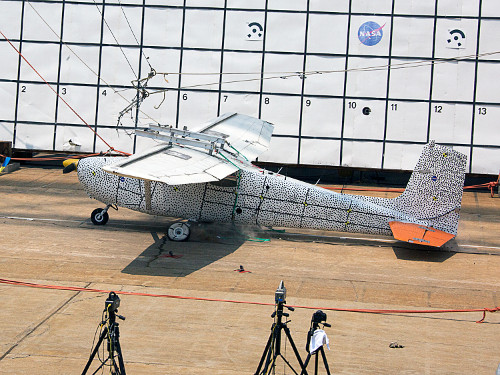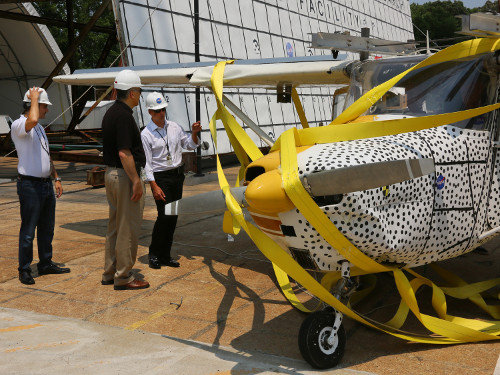 |
| July 28, 2015 | Volume 11 Issue 28 |
Designfax weekly eMagazine
Archives
Partners
Manufacturing Center
Product Spotlight
Modern Applications News
Metalworking Ideas For
Today's Job Shops
Tooling and Production
Strategies for large
metalworking plants
NASA crash test assesses plane emergency locator transmitters

A Cessna 172 was dropped to the concrete from 82 ft at the Landing and Impact Research Facility at NASA's Langley Research Center in Hampton, VA, in July. The research aimed to test the performance of four emergency locator transmitters installed on board, since studies show they don't always work correctly. [Credits: NASA]
By Kathy Barnstorff, NASA Langley Research Center
The Cessna 172 airplane dangled 82 feet in the air, looking almost like it was coming in for a landing, except for the cables attaching it to a huge gantry at NASA's Langley Research Center in Hampton, VA.
Technicians had hauled the 1958 vintage plane to that height, so researchers could drop it to test four emergency locator transmitters (ELTs) installed on board. The research, funded by the NASA Search and Rescue Mission Office at NASA's Goddard Space Flight Center in Greenbelt, MD, is designed to improve the emergency transmitters' performance.
"Too often they fail to work as expected, in part, because of inadequate performance specifications in several areas including vibration, fire survivability, automatic activation, crash safety, and system installation," said Chad Stimson, NASA Langley Emergency Locator Transmitter Survivability and Reliability (ELTSAR) project manager.
According to specifications, ELTs are supposed to transmit the distress signal within 50 seconds of an airplane crash. Current models send the signal to an orbiting satellite, which then gets repeated to the nearest Search and Rescue (SAR) ground station. That data is used to compute with a location, which is sent to rescue personnel.
"It's not obvious to the public what NASA does with search and rescue," said Lisa Mazzuca, NASA SAR mission manager. "There needs to be a technical arm that typically works in the background to allow search-and-rescue forces to affect rescues using satellite-based technology. NASA's here to innovate that technology, which will ultimately improve the probability of a successful rescue."
The ELTSAR research started out with this question: How can ELTs be improved at a system level?
"What we found was we needed to study ELTs at the component level first to better understand why the systems fail," said Stimson.

The crash test simulated a controlled emergency landing on a highway or runway. Technicians had to set up a large yellow net to keep the plane from going into a pool that is used for spacecraft water impact testing. [Credits: NASA Langley/David C. Bowman]
That's where the crash test came in. Stimson and his team did some laboratory testing of ELT components, including drop and vibration tests of beacons and strength and fire testing of cabling. But to test the system as a whole, NASA Langley technicians put four brand new, commercially available emergency beacon installations in the Cessna.
They picked the Cessna because it is the most common general aviation airframe of all time, and ELTSAR research revealed no correlation between ELT performance and any particular aircraft. In fact, the team secured three Cessnas for three different tests from private owners willing to sell their aircraft for the sake of research.
The first drop test, conducted July 1, simulated a controlled emergency landing on a highway or runway. The plane, equipped with two crash test dummies, fell at 72 feet per second onto a concrete surface. Sensors inside collected 64 channels of data, while 40 cameras inside and out recorded the crash.
Even the plane's unusual black-and-white speckled paint job helped with the data collection. It was for a technique called full-field photogrammetry. High-speed cameras filming at 500 images per second tracked each dot, so after the drop researchers can plot and see exactly how crash loads affected the aircraft.
Researchers also used a net for the first time ever to catch the plane before it could slide into a water basin that was built four years ago for spacecraft water testing at the end of the Landing and Impact Research Facility. The drop and the net worked as expected, but some of the ELTs did not.
Early results showed only one of the four transmitters went off and started sending location signals within the first 50 seconds. The others triggered a short time later.
"Everything worked," Stimson said after it was all over. "But the team will take some time to sort out why the ELTs performed the way they did."
Researchers will apply lessons learned from this experiment to get ready for the next drop test, which is expected to happen later in the summer. In the meantime, analysts will use the data collected to validate and correlate computer crashworthiness models. Those models could be a big help in trying to determine the best way to install emergency locater transmitter systems in the future.
Published July 2015
Rate this article
View our terms of use and privacy policy
